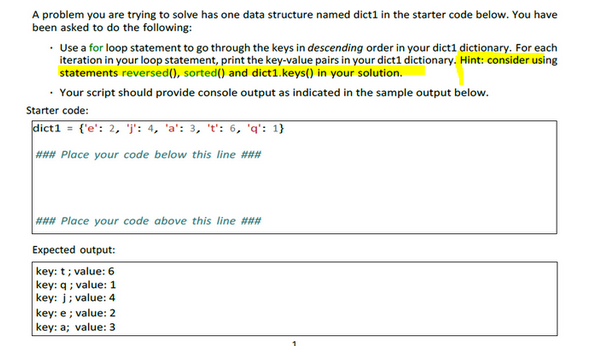A problem you are trying to solve has one data structure named dict1 in the starter code below. You have been asked to do the following: - Use a for loop statement to go through the keys in descending order in your dict1 dictionary. For each iteration in your loop statement, print the key-value pairs in your dict1 dictionary. Hint: consider using statements reversed(), sorted() and dict1.keys() in your solution. Your script should provide console output as indicated in the sample output below. Starter code: dict1 = {'e': 2, 'j': 4, 'a': 3, 't': 6, 'q': 1} ### Place your code below this line ### . ### Place your code above this line ### Expected output: key: t; value: 6 key: q; value: 1 key: j; value: 4 key: e; value: 2 key: a; value: 3
A problem you are trying to solve has one data structure named dict1 in the starter code below. You have been asked to do the following: - Use a for loop statement to go through the keys in descending order in your dict1 dictionary. For each iteration in your loop statement, print the key-value pairs in your dict1 dictionary. Hint: consider using statements reversed(), sorted() and dict1.keys() in your solution. Your script should provide console output as indicated in the sample output below. Starter code: dict1 = {'e': 2, 'j': 4, 'a': 3, 't': 6, 'q': 1} ### Place your code below this line ### . ### Place your code above this line ### Expected output: key: t; value: 6 key: q; value: 1 key: j; value: 4 key: e; value: 2 key: a; value: 3
Computer Networking: A Top-Down Approach (7th Edition)
7th Edition
ISBN:9780133594140
Author:James Kurose, Keith Ross
Publisher:James Kurose, Keith Ross
Chapter1: Computer Networks And The Internet
Section: Chapter Questions
Problem R1RQ: What is the difference between a host and an end system? List several different types of end...
Related questions
Question

Transcribed Image Text:A problem you are trying to solve has one data structure named dict1 in the starter code below. You have
been asked to do the following:
• Use a for loop statement to go through the keys in descending order in your dict1 dictionary. For each
iteration in your loop statement, print the key-value pairs in your dict1 dictionary. Hint: consider using
statements reversed(), sorted() and dict1.keys() in your solution.
• Your script should provide console output as indicated in the sample output below.
Starter code:
dict1 = {'e': 2, 'j': 4, 'a': 3, 't': 6, 'q': 1}\
### Place your code below this line ###
### Place your code above this line ###
Expected output:
key: t; value: 6
key: q; value: 1
key: j; value: 4
key: e; value: 2
key: a; value: 3
Expert Solution
This question has been solved!
Explore an expertly crafted, step-by-step solution for a thorough understanding of key concepts.
This is a popular solution!
Trending now
This is a popular solution!
Step by step
Solved in 3 steps with 1 images

Recommended textbooks for you

Computer Networking: A Top-Down Approach (7th Edi…
Computer Engineering
ISBN:
9780133594140
Author:
James Kurose, Keith Ross
Publisher:
PEARSON

Computer Organization and Design MIPS Edition, Fi…
Computer Engineering
ISBN:
9780124077263
Author:
David A. Patterson, John L. Hennessy
Publisher:
Elsevier Science

Network+ Guide to Networks (MindTap Course List)
Computer Engineering
ISBN:
9781337569330
Author:
Jill West, Tamara Dean, Jean Andrews
Publisher:
Cengage Learning

Computer Networking: A Top-Down Approach (7th Edi…
Computer Engineering
ISBN:
9780133594140
Author:
James Kurose, Keith Ross
Publisher:
PEARSON

Computer Organization and Design MIPS Edition, Fi…
Computer Engineering
ISBN:
9780124077263
Author:
David A. Patterson, John L. Hennessy
Publisher:
Elsevier Science

Network+ Guide to Networks (MindTap Course List)
Computer Engineering
ISBN:
9781337569330
Author:
Jill West, Tamara Dean, Jean Andrews
Publisher:
Cengage Learning

Concepts of Database Management
Computer Engineering
ISBN:
9781337093422
Author:
Joy L. Starks, Philip J. Pratt, Mary Z. Last
Publisher:
Cengage Learning

Prelude to Programming
Computer Engineering
ISBN:
9780133750423
Author:
VENIT, Stewart
Publisher:
Pearson Education

Sc Business Data Communications and Networking, T…
Computer Engineering
ISBN:
9781119368830
Author:
FITZGERALD
Publisher:
WILEY